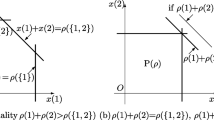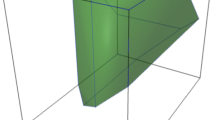Abstract
A bisubmodular polyhedron is defined in terms of a so-called bisubmodular function on a family of ordered pairs of disjoint subsets of a finite set. We examine the structures of bisubmodular polyhedra in terms of signed poset and exchangeability graph. We give a characterization of extreme points together with an O(n 2) algorithm for discerning whether a given point is an extreme point, wheren is the cardinality of the underlying set, and we assume a function evaluation oracle for the bisubmodular function. The algorithm also determines the signed posetructure associated with the given point if it is an extreme point. We reveal the adjacency relation of extreme points by means of the Hasse diagrams of the associated signed posets. Moreover, we investigate the connectivity and the decomposition of a bisubmodular system into its connected components.
Similar content being viewed by others
References
K. Ando and S. Fujishige, “⊓, ⊔-closed families and signed posets,” Report No. 93813, Forschungsinstitut für Diskrete Mathematik, Universität Bonn (Jan. 1994).
K. Ando, S. Fujishige and T. Naitoh, “Proper bisubmodular systems and bidirected flows,” Discussion Paper No. 532, Institute of Socio-Economic Planning, University of Tsukuba (April 1993).
K. Ando, S. Fujishige and T. Nemoto, “Decomposition of a bidirected graph into strongly connected components and its signed poset structure,”Discrete Applied Mathematics 68, (1996) 237–248.
R.E. Bixby, W.H. Cunningham and D.M. Topkis, “Partial order of a polymatroid extreme point,”Mathematics of Operations Research 10 (1985) 367–378.
A. Bouchet, “Greedy algorithm and symmetric matroids,”Mathematical Programming 38 (1987) 147–159.
A. Bouchet, “Matchings and Δ-matroids,”Discrete Mathematics 24 (1989) 55–62.
A. Bouchet and W.H. Cunningham, “Delta-matroids, jump systems and bisubmodular polyhedra,”SIAM Journal on Discrete Mathematics 8 (1995) 17–32.
R. Chandrasekaran and S.N. Kabadi, “Pseudomatroids,”Discrete Mathematics 71 (1988) 205–217.
A. Dress and T. Havel, “Some combinatorial properties of discriminants in metric vector spaces,”Advances in Mathematics 62 (1986) 285–312.
F.D.J. Dunstan and D.J.A. Welsh, “A greedy algorithm for solving a certain class of linear programmes,”Mathematical Programming 62 (1973) 338–353.
J. Edmonds and E.L. Johnson, “Matching: a well-solved class of linear programs,” in: R. Guy, H. Hanani, N. Sauer and J. Schönheim, eds.,Combinatorial Structures and Their Applications (Gordon and Breach, New York, 1970), 88–92.
S. Fujishige,Submodular Functions and Optimization (North-Holland, Amsterdam, 1991).
S. Fujishige, “A min-max theorem for bisubmodular polyhedra,”SIAM Journal on Discrete Mathematics (to appear).
R. Guha, S.N. Kabadi and P. Sharma, “Bisubmodular polyhedra: facets, adjacency and a greedy algorithm,”XVth Internat. Symp. on Mathematical Programming, Ann Arbor, MI (Aug. 1994).
F. Harary, “On the notion of balance of a signed graph,”Michigan Mathematical Journal 2 (1953–1954) 143–146.
S.N. Kabadi,Characterization and Development of Solution Methods for Special Classes of Totally Dual Integral Systems, Dissertation, School of Management, University of Texas at Dallas (1984).
S.N. Kabadi and R. Chandrasekaran, “On totally dual integral systems,”Discrete Applied Mathematics 26 (1990) 87–104.
M. Nakamura, “A characterization of greedy sets: Universal polymatroids (I),”Scientific Papers of the College of Arts and Sciences, University of Tokyo 38 (2) (1988) 155–167.
L. Qi, “Directed submodularity, ditroids and directed submodular flows,”Mathematical Programming 42 (1988) 579–599.
L. Qi, “Bisubmodular functions,” CORE Discussion Paper No. 8901, CORE, Université Catholique de Louvain (1989).
V. Reiner, “Signed posets,”Journal of Combinatorial Theory, Ser. A 62 (1993) 324–360.
A. Schrijver,Matroids and Linking Systems, Mathematical Centre Tracts 88 (Mathematisch Centrum, Amsterdam, 1978).
Author information
Authors and Affiliations
Corresponding author
Rights and permissions
About this article
Cite this article
Ando, K., Fujishige, S. On structures of bisubmodular polyhedra. Mathematical Programming 74, 293–317 (1996). https://doi.org/10.1007/BF02592201
Received:
Revised:
Issue Date:
DOI: https://doi.org/10.1007/BF02592201




